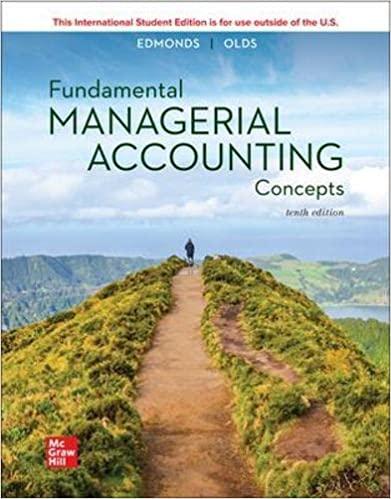Question
The town of Oakwood, Indiana, is considering turning an old railroad bed into a walking and biking trail as part of a Rails to Trails
The town of Oakwood, Indiana, is considering turning an old railroad bed into a walking and biking trail as part of a Rails to Trails initiative. This trail will be called the O-Line Trail. You have been asked to calculate the expected expenses to the town government if the trail is built. In addition, you are to calculate the projected economic costs of this project, which will be used for a cost-benefit analysis of the proposal. The accounting domain for the cost-benefit analysis will be the state of Indiana. No taxes would be owed on purchases, except where noted below.
This trail would extend a total of 10 miles (52,800 linear feet), running from the west side of town, through downtown, to the east side. Although the railroad tracks have been removed, some grading work would need to be done to make the trail suitable for paving. This work will require rental of machinery from one of a number of local rental shops, at a cost of $5.00 per linear foot of trail.
The Trail would consist of asphalt paving that is 10' wide. The current cost for asphalt from local firms is $6.50 per square foot. However, due to the large amount of asphalt needed for the project, it is projected that the towns purchase would lead to the price increasing to $6.90 per square foot, and that the town would have to pay this higher price.
Smith & Co. Pavers, a local firm, would be commissioned to create 90 special street name pavers to be used where the trail intersects with existing streets. Each paver will cost the town $11, which is a $2.00 markup above Smith & Co.s costs.
Trees, bushes, and other landscaping items will be procured from Bobs Nursery, one of many nurseries in the local area. The total bill for these items is projected to be $25,000 per mile of trail, which includes a recently enacted state levied tax on all landscaping purchases of $1,000 per mile.
There will be a number of other features included in several locations along the trail. These include:
human/pet drinking fountains 5 per mile of trail (will be donated to the town by the Oakwood chapter of the Moose Club, who have raised $4,000 for this purpose to order them from an out of state vendor)
park benches 3 per mile of trail (ordered from an out of state vendor at a cost of $330 each, which includes $30 in state sales taxes to the other state)
solar-powered LED lights - 40 (special ordered from Oakwood Hardware at a cost of $355 each, which is $38 above their cost)
trash receptacles - 35 (special ordered from Oakwood Hardware at a cost of $250 each, which is $27 above their cost)
Finally, local construction workers will be hired to work on the project, and it is expected that 20,000 hours of labor will be needed for this project. This is a large change in the local demand for construction workers, and it drives the gross wage up from $15.00 per hour to $16.00/hr. As a result, half of the 20,000 hours hired for the project will come from supply expansion and half will come from demand displacement. In addition $2.00 of that amount is withheld for federal income taxes, and $1.00 is withheld for state income taxes.
Your task is to calculate the government expense for this project along with the economic cost of the project. Complete the below table by creating a row for each input, and listing the expense, any relevant shadow price, and the economic (opportunity) cost, along with the total for each column. Then please answer the following questions:
Provide a short, general description of how expenses were calculated, and give an example describing how you calculated the expenses for one of the inputs.
For each input in Table 1, describe whether, how, and why you adjusted the expense amount to yield the economic (opportunity) cost. You can do this in a bulleted list, but make sure to describe your reasoning for each input.
|
| Table 1. Costs of Inputs for Rails to Trails Project | |||
|
| ||||
| Town of Oakwood Government Expense | Shadow Price | Economic Cost | ||
| Input 1 | $ X1a | $ X1b | $ X1c | |
| Input 2 | $ X2a | $ X2b | $ X2c | |
| Input 3 | $ X3a | $ X3b | $ X3c | |
|
|
|
|
| |
| Total | $ Tota | $ Totb | $ Totc | |
Step by Step Solution
There are 3 Steps involved in it
Step: 1

Get Instant Access to Expert-Tailored Solutions
See step-by-step solutions with expert insights and AI powered tools for academic success
Step: 2

Step: 3

Ace Your Homework with AI
Get the answers you need in no time with our AI-driven, step-by-step assistance
Get Started


